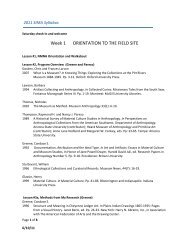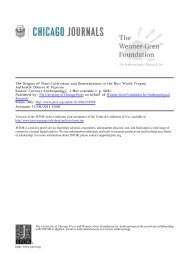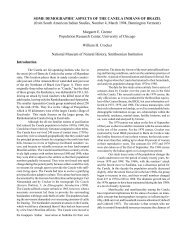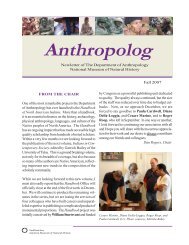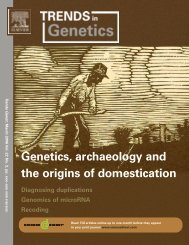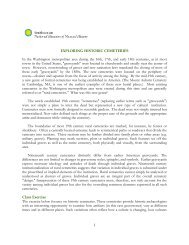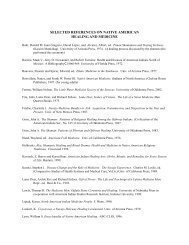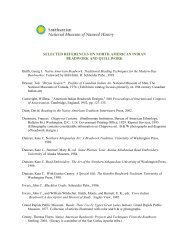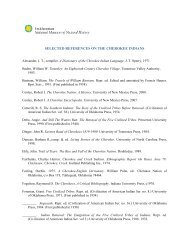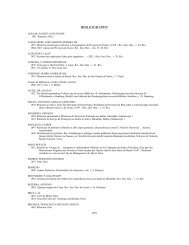2006 Seed Size Increase as a Marker of Domestication in Squash
2006 Seed Size Increase as a Marker of Domestication in Squash
2006 Seed Size Increase as a Marker of Domestication in Squash
You also want an ePaper? Increase the reach of your titles
YUMPU automatically turns print PDFs into web optimized ePapers that Google loves.
Introduction<br />
Among the most b<strong>as</strong>ic questions surround<strong>in</strong>g the orig<strong>in</strong> <strong>of</strong><br />
any plant or animal domesticate are the identity <strong>of</strong> its wild<br />
ancestor and the temporal, spatial, and cultural context <strong>of</strong><br />
its <strong>in</strong>itial domestication. Inherent <strong>in</strong> these questions <strong>of</strong> where<br />
and when a domesticate first emerged is the issue <strong>of</strong> whether<br />
the domestication w<strong>as</strong> a s<strong>in</strong>gle isolated development, or if<br />
multiple <strong>in</strong>dependent domestications <strong>of</strong> a species occurred<br />
at different times <strong>in</strong> different places. The geographical extent<br />
and degree <strong>of</strong> <strong>in</strong>ternal partition<strong>in</strong>g <strong>of</strong> the range <strong>of</strong> a wild<br />
ancestor obviously is an important factor <strong>in</strong> whether s<strong>in</strong>gle<br />
or multiple domestications take place. A s<strong>in</strong>gle orig<strong>in</strong>, for<br />
example, h<strong>as</strong> long been proposed for a number <strong>of</strong> the Near<br />
E<strong>as</strong>tern cereals whose wild ancestors had quite restricted and<br />
<strong>in</strong>ternally unpartitioned geographical ranges (Zohary 1996).<br />
Contrary to Lentz’s recent proposition (Lentz et al. 2001: 375),<br />
such s<strong>in</strong>gle orig<strong>in</strong>s for some cereal domesticates should<br />
not be considered <strong>as</strong> evidence that plant domestication <strong>in</strong><br />
general <strong>in</strong>volves s<strong>in</strong>gle domestication events followed by<br />
diffusion. Multiple domestications are always a possibility<br />
where wild plant or animal progenitor populations extend<br />
across a broad and varied geographical range.<br />
In the Americ<strong>as</strong>, Cucurbita pepo squ<strong>as</strong>h (pumpk<strong>in</strong>s, acorn,<br />
and summer varieties), is, along with Chenopodium (Chapter 4),<br />
one <strong>of</strong> the best-documented species to have been domesticated<br />
more than once from wild ancestor populations hav<strong>in</strong>g<br />
a broad geographical range. More than 10 different taxa<br />
<strong>of</strong> wild Cucurbita gourds have overlapp<strong>in</strong>g geographical<br />
distributions that today extend from northern South America<br />
up <strong>in</strong>to the mid-latitude e<strong>as</strong>tern United States (Nee 1990). A<br />
half-dozen domesticated squ<strong>as</strong>hes were developed out <strong>of</strong><br />
these wild Cucurbita taxa (i.e., C. maxima, C. moschata,<br />
C. ficafolia, C. argyrosperma, C. equadorensis, C. pepo: Rob<strong>in</strong>son<br />
and Decker-Walters 1997; Piperno and Stothert 2003; Sanjur<br />
et al. 2002, 2004). Among these, Cucurbita pepo w<strong>as</strong> <strong>in</strong>dependently<br />
domesticated twice—first <strong>in</strong> south central Mexico about<br />
10,000 years ago and then aga<strong>in</strong>, on the b<strong>as</strong>is <strong>of</strong> currently<br />
available archaeological evidence, <strong>in</strong> the mid-latitude e<strong>as</strong>tern<br />
woodlands <strong>of</strong> North America by about 5,000 years ago (Smith<br />
1997, 2000, 2002). In both Mexico and the e<strong>as</strong>tern United<br />
States, this <strong>in</strong>dependent domestication <strong>of</strong> C. pepo squ<strong>as</strong>h is<br />
<strong>in</strong>dicated by clear changes <strong>in</strong> the morphology <strong>of</strong> C. pepo<br />
C HAPTER 3<br />
<strong>Seed</strong> <strong>Size</strong> <strong>Incre<strong>as</strong>e</strong> <strong>as</strong> a <strong>Marker</strong> <strong>of</strong> <strong>Domestication</strong> <strong>in</strong> Squ<strong>as</strong>h<br />
(Cucurbita pepo)<br />
BRUCE D. SMITH<br />
recovered from human habitation layers <strong>in</strong> archaeological<br />
sites. These morphological changes dist<strong>in</strong>guish the early<br />
domesticated crop plants from all <strong>of</strong> their related wild taxa,<br />
<strong>in</strong>clud<strong>in</strong>g their direct wild ancestors, and they have also<br />
been l<strong>in</strong>ked to a specific set <strong>of</strong> causative human behaviors—<br />
the deliberate and susta<strong>in</strong>ed plant<strong>in</strong>g <strong>of</strong> stored seed stock.<br />
Morphological <strong>Marker</strong>s <strong>of</strong> <strong>Domestication</strong><br />
In the 1960s and 1970s, Harlan, de Wet, and Price published<br />
a series <strong>of</strong> articles that outl<strong>in</strong>ed a clear set <strong>of</strong> morphological<br />
criteria for dist<strong>in</strong>guish<strong>in</strong>g between wild and domesticated<br />
seed plants b<strong>as</strong>ed on changes <strong>in</strong> reproductive propagules<br />
result<strong>in</strong>g from the storage, plant<strong>in</strong>g, and harvest<strong>in</strong>g <strong>of</strong> seed<br />
stock over a number <strong>of</strong> years (Harlan and de Wet 1965;<br />
Harlan et al. 1973; de Wet and Harlan 1975). These morphological<br />
changes, which reflect responses by the now managed<br />
plants to new sets <strong>of</strong> selective pressures, both <strong>in</strong> the seedbed<br />
and at harvest, are automatic and <strong>in</strong>dependent <strong>of</strong> any<br />
deliberate or directed selection on the part <strong>of</strong> humans; they<br />
have collectively been termed “the adaptive syndrome<br />
<strong>of</strong> domestication” (Chapter 1, 2; Smith 1998, 2002). Those<br />
plants with seeds tightly clustered and tightly held at the<br />
term<strong>in</strong>al ends <strong>of</strong> their stalks, for example, would have a<br />
selective advantage at harvest <strong>in</strong> that they would be more<br />
likely to be seen and successfully collected and thus to<br />
contribute to next year’s plant<strong>in</strong>g. Similarly, seeds that sprout<br />
quickly because <strong>of</strong> reduced germ<strong>in</strong>ation dormancy (th<strong>in</strong>ner<br />
seed coat—see Chapter 4) and that grow rapidly (greater<br />
stored start-up energy, larger seed) <strong>in</strong> seedbeds would have<br />
a selective advantage <strong>in</strong> terms <strong>of</strong> compet<strong>in</strong>g for sunlight and<br />
surviv<strong>in</strong>g to be harvested.<br />
Unfortunately, most <strong>of</strong> the morphological changes <strong>in</strong> seed<br />
plants identified by Harlan and others <strong>as</strong> result<strong>in</strong>g from<br />
deliberate human plant<strong>in</strong>g and harvest<strong>in</strong>g are difficult to<br />
document <strong>in</strong> archaeobotanical <strong>as</strong>semblages. One <strong>of</strong> the most<br />
obvious, and most archaeologically visible, <strong>of</strong> these changes<br />
that mark <strong>in</strong>itial domestication is an <strong>in</strong>cre<strong>as</strong>e <strong>in</strong> seed size <strong>in</strong><br />
response to seedbed selective pressures.<br />
In order to use seed size <strong>as</strong> a criterion for differentiat<strong>in</strong>g<br />
between the seeds <strong>of</strong> wild and domesticated C. pepo squ<strong>as</strong>h,<br />
a comprehensive standard, or b<strong>as</strong>el<strong>in</strong>e, <strong>of</strong> comparison <strong>of</strong> seed<br />
me<strong>as</strong>urements for wild Cucurbita taxa is needed. Figures 3.1<br />
SEED SIZE INCREASE OF SQUASH 25
10<br />
8<br />
6<br />
4<br />
Phillips Spr<strong>in</strong>g<br />
a<br />
2<br />
0<br />
6 7 8 9 10 11 12 13 14<br />
10<br />
8<br />
6<br />
4<br />
Page-Ladson<br />
b<br />
2<br />
0<br />
6 7 8 9 10 11 12 13 14<br />
20<br />
15<br />
10<br />
5<br />
C. pep ssp. ovifera var. ozarkana<br />
c 0<br />
6 7 8 9 10 11 12 13 14<br />
10<br />
8<br />
6<br />
4<br />
C. pepo ssp. ovifera var. texana<br />
d<br />
2<br />
0<br />
6 7 8 9 10 11 12 13 14<br />
10<br />
8<br />
6<br />
4<br />
C. fraterna<br />
e<br />
2<br />
0<br />
6 7 8 9 10 11 12 13 14<br />
<strong>Seed</strong> Length (mm)<br />
FIGURE 3.1 The size <strong>of</strong> Cucurbita pepo seeds from<br />
archaeological and paleontological sites <strong>in</strong> North America<br />
compared to three taxa <strong>of</strong> modern wild C. pepo gourds.<br />
(a) Phillip Spr<strong>in</strong>g (n = 45, mean = 10.5); (b) Page-Ladson<br />
(n = 35, mean = 9.9); (c) C. pepo ssp. ovifera var. ozarkana<br />
(n = 100, mean = 9.2); (d) C. pepo ssp. ovifera var. texana<br />
(n = 42, mean = 8.9); (e) C. pepo ssp. ovifera var. fraterna<br />
(n = 13, mean = 7.9).<br />
and 3.2 provide such a general wild Cucurbita gourd seed<br />
pr<strong>of</strong>ile. More than 700 seeds from 63 separate accessions,<br />
represent<strong>in</strong>g 12 modern species, subspecies, or varieties <strong>of</strong><br />
wild Cucurbita gourds were me<strong>as</strong>ured. With the exception<br />
<strong>of</strong> C. pedatifolia and C. galeottii, all known North American<br />
(Mexican and U.S.) wild Cucurbita species are represented <strong>in</strong><br />
Figures 3.1 and 3.2 (see Nee 1990: 58). In addition to the 12<br />
modern taxa <strong>in</strong>cluded <strong>in</strong> Figures 3.1 and 3.2, seed length<br />
<strong>in</strong>formation is also presented for the Page-Ladson seed<br />
<strong>as</strong>semblage (Figure 3.1b), a collection <strong>of</strong> late Pleistocene seeds<br />
<strong>of</strong> a wild Cucurbita gourd recovered from American M<strong>as</strong>todon<br />
(Mammut americanum) dung deposits <strong>in</strong> north Florida<br />
(Newsom et al. 1993). Of the more than 700 modern seeds<br />
me<strong>as</strong>ured, the smallest w<strong>as</strong> 7.0 mm long (Figures 3.1c and e,<br />
Figure 3.2g), while the largest w<strong>as</strong> 11.9 mm <strong>in</strong> length<br />
(Figure 3.2b). The largest seeds <strong>in</strong> 10 <strong>of</strong> the 13 different taxa<br />
exceeded 10 mm <strong>in</strong> length, but none were larger than 12 mm<br />
long (only 6 <strong>of</strong> the 717 seeds were longer than 11 mm and<br />
only 1 me<strong>as</strong>ured more than 11.5 mm <strong>in</strong> length). These<br />
maximum-length values provide a strong b<strong>as</strong>is for def<strong>in</strong><strong>in</strong>g<br />
the upper size-range ceil<strong>in</strong>g for seeds <strong>of</strong> North American<br />
wild Cucurbita gourds at 11–12 mm <strong>in</strong> length.<br />
At the species level <strong>of</strong> comparison, the three C. pepo taxa<br />
listed <strong>in</strong> Figure 3.1c–e (C. pepo ssp. ovifera var. ozarkana,<br />
C. pepo ssp. ovifera var. texana, C. pepo ssp. fraterna) provide<br />
26 ARCHAEOLOGY AND PLANT DOMESTICATION<br />
10<br />
8<br />
6<br />
4<br />
2<br />
a 0<br />
10<br />
8<br />
6<br />
4<br />
2<br />
b 0<br />
10<br />
8<br />
6<br />
4<br />
2<br />
c 0<br />
10<br />
8<br />
6<br />
4<br />
2<br />
d 0<br />
10<br />
8<br />
6<br />
4<br />
2<br />
e 0<br />
f<br />
10<br />
8<br />
6<br />
4<br />
2<br />
0<br />
Level D<br />
Level C<br />
Level B<br />
6 7 8 9 10 11 12 13 14<br />
6 7 8 9 10 11 12 13 14<br />
C. okeechobeenis<br />
C. mart<strong>in</strong>ezii<br />
6 7 8 9 10 11 12 13 14<br />
C. gracilior<br />
C. cordata<br />
Guilá Naquitz<br />
C. palmata<br />
C. okeechobeensis<br />
C. mart<strong>in</strong>ezii<br />
C. gracilior<br />
C. cordata<br />
6 7 8 9 10 11 12 13 14<br />
C. argyrosperma ssp. sororia<br />
6 7 8 9 10 11 12 13 14<br />
C. lundelliana<br />
6 7 8 9 10 11 12 13 14<br />
10<br />
8<br />
6<br />
4<br />
C. foetidissima<br />
C. digitata<br />
C. foetidissima<br />
C. digitata<br />
2<br />
g 0<br />
6 7 8 9 10 11 12 13 14<br />
<strong>Seed</strong> Length (mm)<br />
FIGURE 3.2 The size <strong>of</strong> Cucurbita pepo seeds from Guilá<br />
Naquitz compared to six taxa <strong>of</strong> modern wild Cucurbita<br />
gourds. (a) Guilá Naquitz, Levels B, C, and D (n = 15);<br />
(b) C. palmata (n = 75, mean = 10.2); (c) C. okeechobeensis<br />
(n = 20, mean = 9.9) and C. mart<strong>in</strong>ezii (n = 46, mean = 9.9);<br />
(d) C. gracilior (n = 10, mean = 10.7) and C. cordata (n = 10,<br />
mean = 9.5); (e) C. argyrosperma ssp. sororia (n = 75,<br />
mean = 9.7); (f) C. lundelliana (n = 50, mean = 9.0);<br />
(g) C. foetidissima (n = 55, mean = 8.7) and C. digitata<br />
(n = 20, mean = 8.8).<br />
a smaller, taxonomically tighter, reference cl<strong>as</strong>s, with their<br />
upper limit for seed length (ca. 11 mm) represent<strong>in</strong>g a more<br />
closely drawn wild/domesticated boundary l<strong>in</strong>e than the<br />
12-mm seed length ceil<strong>in</strong>g derived from the 13-taxa<br />
reference cl<strong>as</strong>s. These three modern taxa <strong>of</strong> wild, or “freeliv<strong>in</strong>g,”<br />
Cucurbita gourds actually represent an even tighter,<br />
more focused reference cl<strong>as</strong>s <strong>in</strong> that recent genetic research<br />
(Sanjur et al. 2002, 2004) h<strong>as</strong> identified them <strong>as</strong> not<br />
only closely related to each other, but also <strong>as</strong> a group<br />
represent<strong>in</strong>g the present-day descendants <strong>of</strong> the wild<br />
progenitor populations <strong>of</strong> Cucurbita gourds that gave rise to<br />
the “e<strong>as</strong>tern” l<strong>in</strong>eage <strong>of</strong> domesticated squ<strong>as</strong>h (C. pepo. ssp.<br />
ovifera) about 5,000 years ago. A previous study (Decker-<br />
Walters et al. 1993) had identified one <strong>of</strong> these three—the<br />
wild Ozark gourd (C. pepo ssp. ovifera var. ozarkana)—<strong>as</strong><br />
the progenitor <strong>of</strong> the C. pepo ssp. ovifera domesticate
Huitzo<br />
Etla<br />
ETLA SUBVALLEY<br />
Zaachila<br />
Rio Aloyac<br />
Zimatlan<br />
Oaxaca<br />
Ocollán<br />
LOCATION OF VALLEY OF OAXACA<br />
Ab<strong>as</strong>olo<br />
Tlacolula<br />
Rio Salado<br />
ZAACHILA-ZIMATLAN SUBVALLEY<br />
FIGURE 3.3 The location <strong>of</strong> Guilá Naquitz Cave <strong>in</strong> the<br />
Valley <strong>of</strong> Oaxaca (after Flannery 1986: Figure 3.1).<br />
l<strong>in</strong>eage, but the progenitor pool and the geographical range<br />
with<strong>in</strong> which domestication occurred h<strong>as</strong> now been<br />
expanded. Unfortunately, present-day populations <strong>of</strong> the<br />
wild ancestor <strong>of</strong> the Mexican domesticated C. pepo squ<strong>as</strong>h<br />
l<strong>in</strong>eage have yet to be located. S<strong>in</strong>ce the seeds <strong>of</strong> modern<br />
cultivars <strong>of</strong> the “e<strong>as</strong>tern” l<strong>in</strong>eage <strong>of</strong> C. pepo are smaller than<br />
those <strong>of</strong> the Mexican l<strong>in</strong>eage, this size difference could also<br />
have existed, some scholars have suggested, <strong>in</strong> the wild<br />
ancestor populations (Rob<strong>in</strong>son and Decker-Walters 1997: 7).<br />
As a result, although 11 mm represents a good m<strong>in</strong>imum<br />
length boundary for identify<strong>in</strong>g domesticated C. pepo seeds<br />
<strong>in</strong> e<strong>as</strong>tern United States archaeological contexts, the larger<br />
reference cl<strong>as</strong>s value <strong>of</strong> 12 mm provides a more prudent<br />
m<strong>in</strong>imum seed-length boundary for the designation <strong>of</strong> domesticated<br />
C. pepo <strong>in</strong> Mexico, at le<strong>as</strong>t until the wild progenitor<br />
<strong>of</strong> the Mexican C. pepo l<strong>in</strong>eage h<strong>as</strong> been identified.<br />
Given these m<strong>in</strong>imum seed-length values <strong>of</strong> 11 mm and<br />
12 mm for establish<strong>in</strong>g the <strong>in</strong>itial appearance <strong>of</strong> domesticated<br />
C. pepo squ<strong>as</strong>h <strong>in</strong> the e<strong>as</strong>tern United States and Mexico, we<br />
can turn to consideration <strong>of</strong> the archaeological sites and<br />
human habitation layers that have yielded the oldest seeds<br />
exceed<strong>in</strong>g these seed-length thresholds.<br />
The Cucurbita pepo <strong>Seed</strong> and Peduncle<br />
Assemblage <strong>of</strong> Guilá Naquitz Cave<br />
TLACOLULA SUBVALLEY<br />
Guilá Naquitz<br />
Mitla<br />
0 5 10<br />
km<br />
Situated <strong>in</strong> a small tributary canyon <strong>of</strong> the Rio Mitla <strong>in</strong> the<br />
Valley <strong>of</strong> Oaxaca (Figure 3.3), Guilá Naquitz Cave w<strong>as</strong><br />
excavated by Kent Flannery <strong>in</strong> 1966 (Flannery 1986). The<br />
small 8- by 10-m cave open<strong>in</strong>g at the b<strong>as</strong>e <strong>of</strong> the canyon wall<br />
w<strong>as</strong> found to conta<strong>in</strong> a 20-cm-thick habitation layer (Zone<br />
A) dat<strong>in</strong>g to AD 620–740, and below this, a number <strong>of</strong> much<br />
+<br />
N<br />
FIGURE 3.4 Cucurbita pepo seeds from Guilá Naquitz Cave<br />
yield<strong>in</strong>g AMS dates <strong>in</strong> the Early Archaic. (a) seed from Square<br />
C11, Zone B2 (INAH 5) me<strong>as</strong>ur<strong>in</strong>g 12.5 mm <strong>in</strong> length and<br />
yield<strong>in</strong>g an AMS radiocarbon date <strong>of</strong> 6475 cal. BC; (b) seed<br />
from Square E9, Zone C (INAH 14) me<strong>as</strong>ur<strong>in</strong>g 13.8 mm <strong>in</strong><br />
length and yield<strong>in</strong>g an AMS radiocarbon date <strong>of</strong> 7975 cal<br />
BC; (c) seed from Square E11, Zone B1 (INAH 23) me<strong>as</strong>ur<strong>in</strong>g<br />
13.2 mm <strong>in</strong> length and yield<strong>in</strong>g an AMS radiocarbon date <strong>of</strong><br />
8025 cal. BC; (d) <strong>Seed</strong> from Square C11, Zone B1, me<strong>as</strong>ur<strong>in</strong>g<br />
12.1 mm <strong>in</strong> length and yield<strong>in</strong>g an AMS radiocarbon date <strong>of</strong><br />
6265 cal. BC (Table 3.1).<br />
earlier habitation layers (Zones B, C, D, E) result<strong>in</strong>g from a<br />
series <strong>of</strong> <strong>in</strong>termittent short-term se<strong>as</strong>onal occupations by<br />
small family groups that dated between about 8,000 and<br />
10,500 years ago.<br />
These early occupation layers at Guilá Naquitz Cave (Zones<br />
B1, B2, B3, C, D) yielded more than 250 Cucurbita r<strong>in</strong>d<br />
fragments, a half-dozen fruit stems or peduncles, and<br />
17 seeds that were <strong>as</strong>signed to the genus Cucurbita by Thom<strong>as</strong><br />
Whitaker and Hugh Cutler (Whitaker and Cutler 1971, 1986).<br />
In their <strong>in</strong>itial analysis <strong>of</strong> the Guilá Naquitz Cucurbita<br />
<strong>as</strong>semblage, Whitaker and Cutler did not have the benefit<br />
<strong>of</strong> be<strong>in</strong>g able to determ<strong>in</strong>e the age <strong>of</strong> seeds directly through<br />
accelerator m<strong>as</strong>s spectrometer (AMS) small sample radiocarbon<br />
14 dat<strong>in</strong>g; <strong>in</strong> addition, clear standards for establish<strong>in</strong>g<br />
the domesticated status <strong>of</strong> archaeological squ<strong>as</strong>h specimens<br />
had not yet been fully formulated.<br />
The Guilá Naquitz Cucurbita seeds reanalyzed <strong>in</strong> 1996–1997<br />
were all identified <strong>as</strong> C. pepo, b<strong>as</strong>ed on a number <strong>of</strong> dist<strong>in</strong>ctive<br />
morphological characteristics (e.g., uniform color, prom<strong>in</strong>ent<br />
marg<strong>in</strong>al ridge, short marg<strong>in</strong> hairs, naked marg<strong>in</strong> [see<br />
Figure 3.4]; Smith 1997, 2000). N<strong>in</strong>e <strong>of</strong> these seeds fell below<br />
SEED SIZE INCREASE OF SQUASH 27
TABLE 3.1<br />
Direct Accelerator M<strong>as</strong>s Spectrometer Radiocarbon Dates on Early Cucurbita pepo <strong>Seed</strong>s <strong>in</strong> the Americ<strong>as</strong>:<br />
Guilá Naquitz and Phillips Spr<strong>in</strong>g<br />
<strong>Seed</strong><br />
Length Laboratory Site and Dendrocalibrated<br />
(mm) Sample Location Conventional Age a Age b<br />
10.8 ß47293 Phillips Spr<strong>in</strong>g Unit K2 4440 ± 75 5025 ± 75<br />
(ISM#1502)<br />
11.4 ß91404 Guilá Naquitz C11/B1 7720 ± 60 8430 ± 60<br />
12.0 ß91406 Guilá Naquitz C11/B1 7610 ± 60 8375 ± 60<br />
12.1 ß91405 Guilá Naquitz C11/B1 7690 ± 50 8415 ± 50<br />
12.5 ß100763 Guilá Naquitz C11/B2 7710 ± 50 8425 ± 50<br />
13.2 ß100766 Guilá Naquitz E11/B1 8990 ± 60 9975 ± 60<br />
13.8 ß100764 Guilá Naquitz E9/C 8910 ± 50 9925 ± 50<br />
a In radiocarbon years before present.<br />
b Intercept <strong>in</strong> calendar years before present.<br />
the 12-mm seed-length boundary l<strong>in</strong>e for dist<strong>in</strong>guish<strong>in</strong>g<br />
between the seeds <strong>of</strong> wild and domesticated C. pepo (compare<br />
Figure 3.2a with Figure 3.1c–e and Figure 3.2b–g), <strong>in</strong>dicat<strong>in</strong>g<br />
the cont<strong>in</strong>u<strong>in</strong>g use <strong>of</strong> wild Cucurbita gourds throughout the<br />
early occupations <strong>of</strong> the cave. In contr<strong>as</strong>t, six seeds fell at or<br />
above the 12-mm divid<strong>in</strong>g l<strong>in</strong>e, <strong>in</strong>dicat<strong>in</strong>g the cultivation <strong>of</strong><br />
domesticated C. pepo plants by the early <strong>in</strong>habitants <strong>of</strong> Guilá<br />
Naquitz. The fruit stems, or peduncles, and fruit end r<strong>in</strong>d<br />
fragments hav<strong>in</strong>g peduncle scars, recovered from the early<br />
occupation levels at Guilá Naquitz provide further evidence<br />
that the <strong>in</strong>habitants <strong>of</strong> this cave both harvested wild Cucurbita<br />
gourds and cultivated domesticated C. pepo squ<strong>as</strong>h. Ten<br />
<strong>of</strong> the peduncle scars and peduncles conformed to the wild<br />
gourd morphotype <strong>in</strong> terms <strong>of</strong> form and size (maximum<br />
b<strong>as</strong>al diameter 13 mm and roughly circular outl<strong>in</strong>e). A<br />
second group <strong>of</strong> seven peduncles and peduncle scars, <strong>in</strong><br />
contr<strong>as</strong>t, were considerably larger than the wild morphotype<br />
pr<strong>of</strong>ile (maximum b<strong>as</strong>al diameter 14.7–23.6 mm), and<br />
all had a dist<strong>in</strong>ctive angular pentagonal outl<strong>in</strong>e at the po<strong>in</strong>t<br />
<strong>of</strong> attachment to the fruit. A characteristic 10-ridge lob<strong>in</strong>g<br />
pattern also identifies them <strong>as</strong> C. pepo (Smith 1997).<br />
While the recovery <strong>of</strong> C. pepo seeds that are substantially<br />
larger than those produced by wild Cucurbita gourds <strong>in</strong> the<br />
early habitation layers <strong>of</strong> the cave provides good evidence<br />
for the adaptive syndrome <strong>of</strong> domestication—an automatic<br />
adaptive response by squ<strong>as</strong>h plants to new seed bed selective<br />
pressures <strong>as</strong>sociated with deliberate and susta<strong>in</strong>ed plant<strong>in</strong>g—<br />
the size <strong>in</strong>cre<strong>as</strong>e <strong>in</strong> peduncles reflects deliberate human<br />
selection for larger fruits. Such evidence <strong>of</strong> <strong>in</strong>tentional<br />
selection for desired characteristics follows more than a thousand<br />
years after an <strong>in</strong>cre<strong>as</strong>e <strong>in</strong> seed size <strong>in</strong>dicates deliberate<br />
plant<strong>in</strong>g and <strong>in</strong>itial domestication.<br />
A total <strong>of</strong> 40 radiocarbon dates have been obta<strong>in</strong>ed on plant<br />
rema<strong>in</strong>s from Guilá Naquitz Cave (Smith 2000; Piperno<br />
and Flannery 2001), <strong>in</strong>clud<strong>in</strong>g four direct AMS dates on<br />
C. pepo peduncles and six direct AMS dates on C. pepo seeds<br />
(Table 3.1). The five directly dated C. pepo seeds that fall<br />
28 ARCHAEOLOGY AND PLANT DOMESTICATION<br />
above the 12-mm maximum length for the wild morphotype<br />
reference cl<strong>as</strong>s, and which can be considered <strong>as</strong> represent<strong>in</strong>g<br />
domesticated plants, are all more than 8,400 years old, with<br />
the two oldest <strong>of</strong> the dated seeds <strong>in</strong>dicat<strong>in</strong>g that the familysized<br />
groups that were se<strong>as</strong>onally occupy<strong>in</strong>g Guilá Naquitz<br />
were cultivat<strong>in</strong>g a large-seeded C. pepo squ<strong>as</strong>h <strong>as</strong> early <strong>as</strong><br />
10,000 years ago. In contr<strong>as</strong>t, the first peduncles to fall above<br />
the 13-mm upper boundary for wild morphotype Cucurbita<br />
gourds do not appear until 8,400 years ago, and they show<br />
a subsequent steady size <strong>in</strong>cre<strong>as</strong>e over time (Figure 3.5).<br />
The C. pepo <strong>Seed</strong> and Peduncle Assemblage<br />
from the Phillips Spr<strong>in</strong>g Site<br />
Located adjacent to an artesian spr<strong>in</strong>g on a terrace <strong>of</strong> the<br />
Pomme de Terre River <strong>in</strong> west central Missouri (Figure 3.6),<br />
the water-saturated habitation layers <strong>of</strong> the Phillips Spr<strong>in</strong>g<br />
site yielded abundant and well-preserved plant rema<strong>in</strong>s when<br />
excavated <strong>in</strong> the 1970s (Kay et al. 1980), <strong>in</strong>clud<strong>in</strong>g uncarbonized<br />
r<strong>in</strong>d fragments, seeds, and fruit stems <strong>as</strong>signable to<br />
the genus Cucurbita. The earliest habitation zone at Phillips<br />
Spr<strong>in</strong>g, Unit K2, sealed beneath a large rock-l<strong>in</strong>ed hearth,<br />
yielded three standard radiocarbon dates (4310 ± 70, 4222 ±<br />
57, 4240 ± 80 BP radiocarbon years), along with approximately<br />
125 whole seeds and fragments identified <strong>as</strong> C. pepo<br />
(Kay et al. 1980: 814; K<strong>in</strong>g 1980: 218, 1985: 81). When<br />
<strong>in</strong>itially analyzed, 62 <strong>of</strong> the C. pepo seeds from Unit K2 (the<br />
“squ<strong>as</strong>h and gourd zone”) provided both length and width<br />
me<strong>as</strong>urements. They ranged <strong>in</strong> length from 8.3 to 12.2 mm,<br />
with a mean length <strong>of</strong> 10.5 mm (K<strong>in</strong>g 1985: 82). Fifteen<br />
years later, reanalysis <strong>of</strong> the Phillips Spr<strong>in</strong>g K2 Cucurbita<br />
<strong>as</strong>semblage produced the same results, even though length<br />
and width me<strong>as</strong>urements could be obta<strong>in</strong>ed on only 45 seeds<br />
(Figure 3.1a; Smith 2000: 54). Assignment <strong>of</strong> the Unit K2<br />
Cucurbita seeds to C. pepo w<strong>as</strong> also confirmed (b<strong>as</strong>ed on<br />
marg<strong>in</strong>al ridge and hair morphology), <strong>as</strong> w<strong>as</strong> the temporal<br />
placement <strong>of</strong> the “squ<strong>as</strong>h and gourd zone.” A direct AMS
FIGURE 3.5 <strong>Incre<strong>as</strong>e</strong> <strong>in</strong> the size <strong>of</strong> peduncles <strong>of</strong><br />
domesticated Cucurbita pepo <strong>in</strong> preceramic habitation zones<br />
<strong>of</strong> Guilá Naquitz Cave between ca. 6500 and 5800 BC<br />
(see Smith 2000: 40).<br />
radiocarbon date <strong>of</strong> 4440 ± 75 BP radiocarbon years (5025<br />
calibrated calendar years BP) w<strong>as</strong> obta<strong>in</strong>ed on one <strong>of</strong> the Unit<br />
K2 seeds (Table 3.1; Smith 2000: 58).<br />
Generally accepted <strong>as</strong> represent<strong>in</strong>g an early stage <strong>of</strong> domesticated<br />
C. pepo <strong>in</strong> the e<strong>as</strong>tern United States, the Unit K2<br />
Phillips Spr<strong>in</strong>g seed <strong>as</strong>semblage h<strong>as</strong> a mean length value<br />
larger than all but one <strong>of</strong> the 13 wild Cucurbita gourd<br />
reference taxa listed <strong>in</strong> Figures 3.1 and 3.2. Significantly,<br />
although only two Phillips Spr<strong>in</strong>g seeds met or exceeded<br />
the 12.0-mm domestication boundary employed for the<br />
Guilá Naquitz <strong>as</strong>semblage, 12 <strong>of</strong> the 45 Unit K2 C. pepo<br />
seeds me<strong>as</strong>ured for the present study exceeded the 11.0-mm<br />
wild seed length ceil<strong>in</strong>g proposed for the e<strong>as</strong>tern United<br />
States, provid<strong>in</strong>g strong evidence for deliberate plant<strong>in</strong>g,<br />
an adaptive response to seedbed selective pressure, and<br />
the <strong>in</strong>dependent domestication <strong>of</strong> C. pepo ssp. ovifera <strong>in</strong> the<br />
e<strong>as</strong>tern United States.<br />
The four fruit-end fragment peduncle scars <strong>in</strong> the Unit K2<br />
Cucurbita <strong>as</strong>semblage, <strong>in</strong> contr<strong>as</strong>t, show no <strong>in</strong>dication <strong>of</strong><br />
morphological changes beyond the parameters <strong>of</strong> the wild<br />
morphotype gourd pr<strong>of</strong>ile. They compare closely to the<br />
wild Ozark gourd (C. pepo ssp. ovifera var. ozarkana) <strong>in</strong> both<br />
diameter and circular outl<strong>in</strong>e, and they appear to be from<br />
small globular fruits. As is the c<strong>as</strong>e <strong>in</strong> the developmental<br />
sequence for the Mexican l<strong>in</strong>eage <strong>of</strong> domesticated C. pepo,<br />
a wide range <strong>of</strong> changes <strong>in</strong> fruit morphology <strong>in</strong>dicative<br />
<strong>of</strong> deliberate and susta<strong>in</strong>ed human selection also appears<br />
<strong>in</strong> the 2,000-year span follow<strong>in</strong>g the 5000 BP Unit K2<br />
Phillips Spr<strong>in</strong>g <strong>as</strong>semblage and its evidence for <strong>in</strong>itial domestication<br />
<strong>of</strong> C. pepo <strong>in</strong> the e<strong>as</strong>tern United States. These changes<br />
Osage<br />
Missouri<br />
River<br />
Warsaw<br />
Pomme<br />
FIGURE 3.6 The location <strong>of</strong> the Phillips Spr<strong>in</strong>g archaeological<br />
site <strong>in</strong> south central Missouri.<br />
<strong>in</strong>clude a diversification <strong>of</strong> fruit forms, surface lob<strong>in</strong>g<br />
and wart<strong>in</strong>g, and an <strong>in</strong>cre<strong>as</strong>e <strong>in</strong> both fruit size and r<strong>in</strong>d<br />
thickness (Cowan 1997: 73).<br />
Discussion—Future Research Directions<br />
Fristoe<br />
Boney Spr<strong>in</strong>g<br />
Rodgers Shelter<br />
Wheatland<br />
N 0 5 km<br />
Phillips Spr<strong>in</strong>g<br />
This chapter marshals archaeological evidence <strong>in</strong> support<br />
<strong>of</strong> the proposition that pepo squ<strong>as</strong>h (Cucurbita pepo) w<strong>as</strong><br />
<strong>in</strong>dependently domesticated twice <strong>in</strong> the Americ<strong>as</strong>: the<br />
pumpk<strong>in</strong> l<strong>in</strong>eage (Cucurbita pepo ssp. pepo <strong>in</strong> Mexico by<br />
10,000 years ago, and the acorn–summer squ<strong>as</strong>h l<strong>in</strong>eage<br />
(Cucurbita pepo ssp. ovifera) <strong>in</strong> the e<strong>as</strong>tern United States by<br />
5,000 years ago. For each <strong>of</strong> these separate domestication<br />
processes, the support<strong>in</strong>g arguments rest on an observed<br />
morphological change—an <strong>in</strong>cre<strong>as</strong>e <strong>in</strong> the size <strong>of</strong> pepo squ<strong>as</strong>h<br />
seeds recovered from an archaeological context beyond what<br />
h<strong>as</strong> been documented <strong>in</strong> modern reference cl<strong>as</strong>s taxa <strong>of</strong><br />
wild Cucurbita gourds. It is important to keep <strong>in</strong> m<strong>in</strong>d that,<br />
while the evidence compiled to date and presented here<br />
constitutes a good beg<strong>in</strong>n<strong>in</strong>g—an <strong>in</strong>itial general spatial and<br />
temporal outl<strong>in</strong>e <strong>of</strong> domestication <strong>in</strong> this species—there is<br />
SEED SIZE INCREASE OF SQUASH 29<br />
Terre<br />
River<br />
Blackwell Cave<br />
Hermitage
still considerable room for strengthen<strong>in</strong>g the support<strong>in</strong>g<br />
arguments, and for expand<strong>in</strong>g the context and scope <strong>of</strong><br />
consideration <strong>of</strong> C. pepo domestication.<br />
The most obvious way <strong>in</strong> which these support<strong>in</strong>g<br />
arguments can be strengthened is through enlarg<strong>in</strong>g the<br />
modern reference cl<strong>as</strong>s <strong>of</strong> seed size me<strong>as</strong>urements, thereby<br />
ensur<strong>in</strong>g that the full range <strong>of</strong> taxonomic and geographical<br />
variation <strong>in</strong> seed size for all <strong>of</strong> the present-day wild taxa<br />
<strong>of</strong> Cucurbita gourds is encomp<strong>as</strong>sed. This is particularly<br />
true for the three modern wild taxa that have the greatest<br />
genetic similarity to the e<strong>as</strong>tern acorn–summer squ<strong>as</strong>h<br />
l<strong>in</strong>eage. While two <strong>of</strong> the three taxa that compose the C. pepo<br />
ssp. ovifera wild progenitor gourd complex—the Ozark and<br />
Tex<strong>as</strong> wild gourds (C. pepo ssp. ovifera varieties texana and<br />
ozarkana)—have been studied to some extent throughout<br />
their geographical range, and have yielded re<strong>as</strong>onably large<br />
and representative samples <strong>of</strong> seeds for modern comparison<br />
collections, the third (C. pepo ssp. ovifera var. fraterna)<br />
is still relatively poorly documented <strong>in</strong> terms <strong>of</strong> both seed<br />
size and natural habitat. B<strong>as</strong>ed on the apparent strong<br />
selective pressures controll<strong>in</strong>g seed and fruit size <strong>in</strong> all <strong>of</strong><br />
the present-day taxa <strong>of</strong> wild morphotype Cucurbita gourds,<br />
however, any expansion <strong>of</strong> modern reference cl<strong>as</strong>s seed size<br />
values beyond that already documented would not be<br />
expected.<br />
Of even more importance, <strong>in</strong> terms <strong>of</strong> strengthen<strong>in</strong>g<br />
our modern reference cl<strong>as</strong>s <strong>of</strong> wild Cucurbita taxa, will be<br />
to identify <strong>in</strong> Mexico, if they are still extant, modern descendant<br />
populations <strong>of</strong> the wild progenitor <strong>of</strong> the Mexican<br />
pumpk<strong>in</strong> l<strong>in</strong>eage <strong>of</strong> domesticated pepo squ<strong>as</strong>h. If such<br />
modern populations <strong>of</strong> the wild gourd that gave rise to<br />
Cucurbita pepo ssp. pepo more than 10,000 years ago still<br />
survive somewhere <strong>in</strong> Mexico, they have not yet been located<br />
and documented, <strong>in</strong> spite <strong>of</strong> fairly substantial field survey<br />
coverage for wild Cucurbita taxa.<br />
At the same time, it will be just <strong>as</strong> important to expand the<br />
reference cl<strong>as</strong>s <strong>of</strong> ancient collections <strong>of</strong> wild Cucurbita taxa<br />
recovered from human contexts and from natural deposits<br />
(e.g., Page-Ladson, Figure 3.1b) over broad spatial and<br />
temporal ranges. It is important to be able to document<br />
that the same strong selective pressures operat<strong>in</strong>g to control<br />
seed size <strong>in</strong> modern wild Cucurbita gourds were also present<br />
<strong>in</strong> the p<strong>as</strong>t, and that wild gourds <strong>in</strong> the early Holocene<br />
did not produce seeds that were larger than their present-day<br />
descendant populations. This ancient reference cl<strong>as</strong>s <strong>of</strong><br />
Cucurbita represents an important <strong>as</strong>pect <strong>of</strong> any support<strong>in</strong>g<br />
argument for domestication. A claim <strong>of</strong> domesticated<br />
status for squ<strong>as</strong>h seeds recovered from an archaeological<br />
context b<strong>as</strong>ed on seed size <strong>in</strong>cre<strong>as</strong>e is considerably strengthened<br />
if the candidate for early domesticate seeds can be<br />
shown not only to be larger than those produced by modern<br />
wild taxa, but also to be larger than seeds produced by<br />
presumably wild gourd taxa <strong>of</strong> the p<strong>as</strong>t. The ideal support<strong>in</strong>g<br />
argument <strong>in</strong> this regard would be a rich and well-documented<br />
deep-time-depth regional archaeobotanical record <strong>of</strong><br />
30 ARCHAEOLOGY AND PLANT DOMESTICATION<br />
human use <strong>of</strong> a small-seeded wild Cucurbita gourd, lead<strong>in</strong>g<br />
up to the appearance <strong>of</strong> a larger seeded (domesticated) form<br />
<strong>in</strong>the archaeological sequence. Support<strong>in</strong>g evidence <strong>of</strong> this<br />
k<strong>in</strong>d does exist to some extent <strong>in</strong> both Mexico (Figure 3.2)<br />
and e<strong>as</strong>tern North America (Figure 3.1) <strong>in</strong> the form <strong>of</strong> small<br />
squ<strong>as</strong>h seeds, likely from wild taxa, occ<strong>as</strong>ionally be<strong>in</strong>g<br />
recovered from scattered archaeological contexts that predate<br />
the appearance <strong>of</strong> large seeds from early domesticates. This<br />
reference cl<strong>as</strong>s, however, needs to be substantially improved<br />
<strong>in</strong> terms <strong>of</strong> both overall seed count and temporal and<br />
spatial coverage.<br />
Another obvious area <strong>of</strong> future research regard<strong>in</strong>g the early<br />
history <strong>of</strong> domesticated pepo squ<strong>as</strong>h <strong>in</strong> the Americ<strong>as</strong> will<br />
<strong>in</strong>volve trac<strong>in</strong>g the tim<strong>in</strong>g <strong>of</strong> <strong>in</strong>troduction <strong>of</strong> the Mexican<br />
pumpk<strong>in</strong> l<strong>in</strong>eage <strong>of</strong> pepo squ<strong>as</strong>h <strong>in</strong>to e<strong>as</strong>tern North America<br />
from the Southwest, and the subsequent manner <strong>in</strong> which<br />
it w<strong>as</strong> variously added <strong>in</strong>to the exist<strong>in</strong>g <strong>in</strong>digenous food<br />
production economies <strong>of</strong> different regions <strong>of</strong> the E<strong>as</strong>t. There<br />
h<strong>as</strong> been considerable recent research on the <strong>in</strong>itial <strong>in</strong>troduction<br />
<strong>of</strong> other crop plants from Mexico, <strong>in</strong>clud<strong>in</strong>g other species<br />
<strong>of</strong> squ<strong>as</strong>h (e.g., Fritz 1994), and it should be possible to<br />
dist<strong>in</strong>guish <strong>in</strong> the archaeological record between the <strong>in</strong>digenous<br />
acorn–summer squ<strong>as</strong>h l<strong>in</strong>eage (C. pepo ssp. ovifera) and<br />
the <strong>in</strong>troduced Mexican pumpk<strong>in</strong> l<strong>in</strong>eage (C. pepo ssp. pepo)<br />
on the b<strong>as</strong>is <strong>of</strong> genetic pr<strong>of</strong>iles <strong>as</strong> well <strong>as</strong> seed, fruit, and<br />
peduncle morphology.<br />
F<strong>in</strong>ally, at the same time that there is considerable room for<br />
strengthen<strong>in</strong>g and expand<strong>in</strong>g the support<strong>in</strong>g arguments<br />
for when and where domestication <strong>of</strong> this important crop<br />
plant took place, there is also a great deal to be learned regard<strong>in</strong>g<br />
the role <strong>of</strong> this species <strong>in</strong> the low-level food production<br />
economies <strong>of</strong> the human societies that first domesticated it<br />
<strong>in</strong> Mexico and the e<strong>as</strong>tern United States so long ago, and<br />
the extent to which it represented a significant change, or if<br />
it <strong>in</strong>itially at le<strong>as</strong>t w<strong>as</strong> just a modest supplement to an<br />
otherwise stable and relatively secure way <strong>of</strong> life.<br />
References<br />
Cowan, C. W. 1997. Evolutionary changes <strong>as</strong>sociated with the<br />
domestication <strong>of</strong> Cucurbita pepo: Evidence from e<strong>as</strong>tern<br />
Kentucky. In People, plants, and landscapes, K. Gremillion (ed.),<br />
pp. 63–85. Tuscaloosa: University <strong>of</strong> Alabama Press.<br />
Decker-Walters, D., T. Walters, C. W. Cowan, and B. D. Smith.<br />
1993. Isozyme characterization <strong>of</strong> wild populations <strong>of</strong> Cucurbita<br />
pepo. Journal <strong>of</strong> Ethnobiology 13: 55–72.<br />
de Wet, J. M. J. and J. R. Harlan. 1975. Weeds and domesticates:<br />
Evolution <strong>in</strong> the man-made habitat. Economic Botany 29:<br />
99–107.<br />
Flannery, K. 1986. Guilá Naquitz. Archaic forag<strong>in</strong>g and early<br />
agriculture <strong>in</strong> Oaxaca, Mexico. New York: Academic Press.<br />
Fritz, G. 1994. Precolumbian Cucurbita argyrosperma ssp.<br />
argyrosperma <strong>in</strong> the western woodlands <strong>of</strong> e<strong>as</strong>tern North<br />
America. Economic Botany 48: 280–292.<br />
Harlan, J. and J. M. J. deWet. 1965. Some thoughts on weeds.<br />
Economic Botany 18: 16–22.
Harlan, J. J., M. J. deWet, and E. G. Price. 1973. Comparative<br />
evolution <strong>of</strong> cereals. Evolution 27: 311–325.<br />
Kay, M., F. B. K<strong>in</strong>g, and C. K. Rob<strong>in</strong>son. 1980. Cucurbits from<br />
Phillips Spr<strong>in</strong>g: New evidence and <strong>in</strong>terpretation. American<br />
Antiquity 45: 806–822.<br />
K<strong>in</strong>g, F. B. 1980. Plant rema<strong>in</strong>s from Phillips Spr<strong>in</strong>g, a multicomponent<br />
site <strong>in</strong> the western Ozark highland <strong>of</strong> Missouri. Pla<strong>in</strong>s<br />
Anthropologist 25: 217–227.<br />
———. 1985. Early cultivated Cucurbits <strong>in</strong> e<strong>as</strong>tern North America.<br />
In Prehistoric Food Production <strong>in</strong> North America, R. I. Ford (ed.),<br />
pp. 73–98. Ann Arbor, Mich.: Museum <strong>of</strong> Anthropology,<br />
University <strong>of</strong> Michigan, Anthropological Papers No. 75.<br />
Lentz, D. W., M. E. D. Pohl, K. O. Pope, and A. R. Wyatt. 2001.<br />
Prehistoric sunflower (Helianthus annuus L.) domestication <strong>in</strong><br />
Mexico. Economic Botany 55: 370–376.<br />
Nee, M. 1990. The domestication <strong>of</strong> Cucurbita (Cucurbitaceae).<br />
Economic Botany 44 (supplement): 56–69.<br />
Newsom, L., S. D. Webb, and J. S. Dunbar. 1993. History and<br />
geographic distribution <strong>of</strong> Cucurbita pepo gourds <strong>in</strong> Florida.<br />
Journal <strong>of</strong> Ethnobiology 13: 75–79.<br />
Piperno, D. and K. Flannery. 2001. The earliest archaeological<br />
maize (Zea mays L.) from highland Mexico: New accelerator<br />
m<strong>as</strong>s spectrometry dates and their implications. Proceed<strong>in</strong>gs <strong>of</strong><br />
the National Academy <strong>of</strong> Sciences 98: 1324–1326.<br />
Piperno, D. and K. Stothert. 2003. Phytolith evidence for Early<br />
Holocene Cucurbita domestication <strong>in</strong> southwest Ecuador.<br />
Science 299: 1054–1057.<br />
Rob<strong>in</strong>son, R. W. and D. Decker-Walters. 1997. Cucurbits. New York:<br />
CAB International.<br />
Sanjur, O., D. Piperno, T. Andres, and L. Wessel-Beaver. 2002.<br />
Phylogenetic relationships among domesticated and wild<br />
species <strong>of</strong> Cucurbita <strong>in</strong>ferred from a mitochondrial gene:<br />
Implications for crop plant evolution and are<strong>as</strong> <strong>of</strong> orig<strong>in</strong>.<br />
Proceed<strong>in</strong>gs <strong>of</strong> the National Academy <strong>of</strong> Sciences, USA 99: 535–540.<br />
———. 2004. Us<strong>in</strong>g molecular markers to study plant domestication:<br />
The c<strong>as</strong>e <strong>of</strong> Cucurbita. In Biomolecular archaeology:<br />
Genetic approaches to the p<strong>as</strong>t. D. M. Reed (ed.), pp. 128–<br />
150. Occ<strong>as</strong>ional Paper No. 32 <strong>of</strong> the Center for Archaeological<br />
Investigations, Southern Ill<strong>in</strong>ois University, Carbondale.<br />
Carbondale, Ill.: CAI, Southern Ill<strong>in</strong>ois University, Carbondale.<br />
Smith, B. D. 1997. The <strong>in</strong>itial domestication <strong>of</strong> Cucurbita<br />
pepo <strong>in</strong> the Americ<strong>as</strong> 10,000 years ago. Science 276: 932–934.<br />
———. 1998. The emergence <strong>of</strong> agriculture. New York: W.H.<br />
Freeman.<br />
———. 2000. Guilá Naquitz revisited. In Cultural evolution:<br />
Contemporary viewpo<strong>in</strong>ts, G. Fe<strong>in</strong>man and L. Manzanilla (eds.),<br />
pp. 15–59. New York: Kluwer Academic/Plenum Publishers.<br />
———. 2002. Rivers <strong>of</strong> change (paperback edition). W<strong>as</strong>h<strong>in</strong>gton,<br />
D.C.: Smithsonian Institution Press.<br />
Whitaker, T. and H. Cutler. 1971. Prehistoric cucurbits from the<br />
Valley <strong>of</strong> Oaxaca. Economic Botany 25: 123–127.<br />
———. 1986. Cucurbits from preceramic levels at Guilá Naquitz.<br />
In Guilá Naquitz: Archaic forag<strong>in</strong>g and early agriculture <strong>in</strong> Oaxaca,<br />
Mexico, K. Flannery (ed.), pp. 275–279. New York: Academic Press.<br />
Zohary, D. 1996. The founder crops <strong>of</strong> southwest Asian agriculture.<br />
In The orig<strong>in</strong>s and spread <strong>of</strong> agriculture and p<strong>as</strong>toralism <strong>in</strong><br />
Eur<strong>as</strong>ia, D. Harris (ed.), pp. 142–158. W<strong>as</strong>h<strong>in</strong>gton, D.C.:<br />
Smithsonian Institution Press.<br />
SEED SIZE INCREASE OF SQUASH 31



